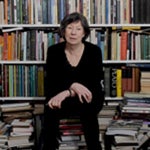Laura Mulvey
Posted in Past Guests | Tagged G-M

Born in Oxford, Laura Mulvey studied history at St. Hilda’s, Oxford University. In the early 1970s, she came to prominence as a film theorist, writing for periodicals such as Spare Rib and Seven Days. Much of her early critical work investigated questions of spectatorial identification and its relationship to the male gaze, and her writings, particularly the 1975 essay “Visual Pleasure and Narrative Cinema,” which was published in the British cinema journal Screen and helped establish feminist film theory as a legitimate field of study.
Between 1974 and 1982, Mulvey co-wrote and co-directed with her husband, Peter Wollen, six projects: theoretical films dealing in the discourse of feminist theory, semiotics, psychoanalysis, and leftist politics. These include Penthesilea: Queen of the Amazons (1974), Riddles of the Sphinx (1977), AMY! (1980), Frida Kahlo and Tina Modotti (1982), and The Bad Sister (1982). Upon the completion of this series, Mulvey did not return to filmmaking until 1991, when she began a solo project, Disgraced Moments, which took a look at the fate of Soviet revolutionary monuments after the fall of communism.
Laura Mulvey is currently a professor of film and media studies at Birbeck College, University of London.
from Visual Pleasure and Narrative Cinema
In a world ordered by sexual imbalance, pleasure in looking has been split between active/male and passive/female. The determining male gaze projects its phantasy onto the female form which is styled accordingly. In their traditional exhibitionist role, women are simultaneously looked at and displayed, with their appearance coded for strong visual and erotic impact so that they can be said to connote to-be-looked-at-ness. Woman displayed as a sexual object is the leitmotif of erotic spectacle: from pin-ups to striptease, from Ziegfeld to Busby Berkeley, she holds the look, plays to and signifies male desire. Mainstream film neatly combines spectacle and narrative. (Note, however, how the musical song-and-dance numbers break the flow of the diegesis.) The presence of woman is an indispensable element of spectacle in normal narrative film, , yet her visual presence tends to work against the development of a storyline, to freeze the flow of action in moments of erotic contemplation. This alien presence then has to be integrated into cohesion with the narrative. As Budd Boetticher has put it:
“What counts is what the heroine provokes, or rather what she represents. She is the one, or rather the love or fear she inspires in the hero, or else the concern he feels for her, who makes him act the way he does. In herself, the woman has not the slightest importance.”
(A recent tendency in narrative film has been to dispense with this problem altogether; hence the development of what Molly Haskell has called the ‘buddy movie,’ in which the active homosexual eroticism of the central male figures can carry the story without distraction.) Traditionally, the woman displayed has functioned on two levels: as an erotic object for the characters within the screen story, and as an erotic object for the spectator within the auditorium, with a shifting tension between the looks on either side of the screen. For instance, the device of the show-girl allows the two looks to be unified technically without any apparent break in the diegesis. A woman performs within the narrative; the gaze of the spectator and that of the male characters in the film are neatly combined without breaking narrative verisimilitude. For a moment, the sexual impact of the performing woman takes the film into a no-man’s land outside its own time and space. Thus Marilyn Monroe’s first appearance in The River of No Return and Lauren Bacall’s songs in To Have or Have Not. Similarly, conventional close-ups of legs (Dietrich, for instance) or a face (Garbo) integrate into the narrative a different mode of eroticism. One part of a fragmented body destroys the Renaissance space, the illusion of depth demanded by the narrative; it gives flatness, the quality of a cut-out or icon rather than verisimilitude to the screen.
–
Continue reading at Lux Online
Links
- Laura Mulvey on the Blonde. British Film Institute. 8 March 2010.
